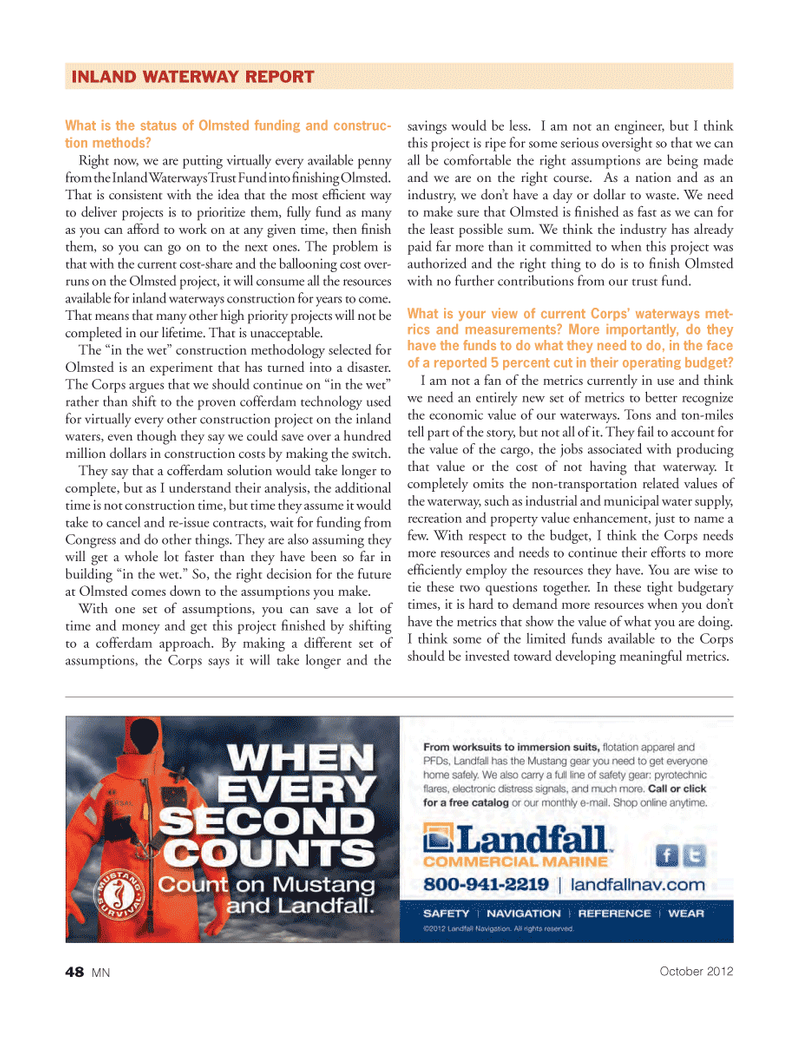
Page 48: of Marine News Magazine (October 2012)
Year in Review & Leadership
Read this page in Pdf, Flash or Html5 edition of October 2012 Marine News Magazine
What is the status of Olmsted funding and construc-tion methods?Right now, we are putting virtually every available penny from the Inland Waterways Trust Fund into Þ nishing Olmsted. That is consistent with the idea that the most efÞ cient way to deliver projects is to prioritize them, fully fund as many as you can afford to work on at any given time, then Þ nish them, so you can go on to the next ones. The problem is that with the current cost-share and the ballooning cost over- runs on the Olmsted project, it will consume all the resources available for inland waterways construction for years to come. That means that many other high priority projects will not be completed in our lifetime. That is unacceptable. The Òin the wetÓ construction methodology selected for Olmsted is an experiment that has turned into a disaster. The Corps argues that we should continue on Òin the wetÓ rather than shift to the proven cofferdam technology used for virtually every other construction project on the inland waters, even though they say we could save over a hundred million dollars in construction costs by making the switch. They say that a cofferdam solution would take longer to complete, but as I understand their analysis, the additional time is not construction time, but time they assume it would take to cancel and re-issue contracts, wait for funding from Congress and do other things. They are also assuming they will get a whole lot faster than they have been so far in building Òin the wet.Ó So, the right decision for the future at Olmsted comes down to the assumptions you make. With one set of assumptions, you can save a lot of time and money and get this project Þ nished by shifting to a cofferdam approach. By making a different set of assumptions, the Corps says it will take longer and the savings would be less. I am not an engineer, but I think this project is ripe for some serious oversight so that we can all be comfortable the right assumptions are being made and we are on the right course. As a nation and as an industry, we donÕt have a day or dollar to waste. We need to make sure that Olmsted is Þ nished as fast as we can for the least possible sum. We think the industry has already paid far more than it committed to when this project was authorized and the right thing to do is to Þ nish Olmsted with no further contributions from our trust fund. What is your view of current Corps? waterways met- rics and measurements? More importantly, do they have the funds to do what they need to do, in the face of a reported 5 percent cut in their operating budget? I am not a fan of the metrics currently in use and think we need an entirely new set of metrics to better recognize the economic value of our waterways. Tons and ton-miles tell part of the story, but not all of it. They fail to account for the value of the cargo, the jobs associated with producing that value or the cost of not having that waterway. It completely omits the non-transportation related values of the waterway, such as industrial and municipal water supply, recreation and property value enhancement, just to name a few. With respect to the budget, I think the Corps needs more resources and needs to continue their efforts to more efÞ ciently employ the resources they have. You are wise to tie these two questions together. In these tight budgetary times, it is hard to demand more resources when you donÕt have the metrics that show the value of what you are doing. I think some of the limited funds available to the Corps should be invested toward developing meaningful metrics. INLAND WATERWAY REPORT 48 MNOctober 2012MNOct2012 Layout 32-49.indd 48MNOct2012 Layout 32-49.indd 4810/2/2012 10:09:42 AM10/2/2012 10:09:42 AM

 47
47

 49
49
